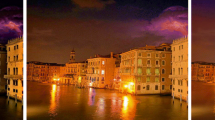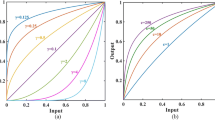Abstract
In the process of the structured light detection, it is affected by many factors such as the light source, object to it-self and environmental noise, which result in poor imaging quality. For this reason, the Radon transformation of multi angle is adopted to get the transform domain image, after obtaining the information of the oblique angle of the structured light stripes. After that the singular points unrelated to the target stripes are eliminated in the transform domain image. Then the processed transform domain image is restored and the noise is eliminated. At the same time, the above-mentioned structured light images are pre-processed by several existing means to eliminate noise. Then compared with the traditional methods, the superiority of the Radon transformation in eliminating noise interference is highlighted by using the reliability evaluation scheme to evaluate the quality of the processed images. Finally, aiming at the other shortcomings in the Radon transformed image and further improving the image quality, the restored images are handled by the gray-scale transformation enhancement to enhance the overall gray level of the image. The experimental results show that the imaging quality of the image processed by the above methods is significantly improved.















Similar content being viewed by others
References
Chen K, Li FC, Li HG (2016) Rolling bearingFault diagnosis based on fast adaptive empirical mode decomposition. Journal of Vibration Measurement & Diagnosis 36:647–652. https://doi.org/10.16450/j.cnki.issn.1004-6801.2016.04.006
Ding C, Tang LW, Cao LJ, Shao XJ, Deng SJ (2017) Height difference detection of barrel rifling based on structured light, vol 25, pp 545–553. https://doi.org/10.3788/OPE.20172504.1077
Ding C, Tang LW, Cao LJ, Shao XJ, Deng SJ (2018) 3D reconstruction of deep-hole inner surface using structured light. Infrared and Laser Engineering, pp 0406004. https://doi.org/10.3788/IRLA201847.0406004
Dobes M, Machala L, Furst T (2010) Blurred image restoration: a fast method of finding the motion length and angle. Digital Signal Process 20:1677–1686. https://doi.org/10.1016/j.dsp.2010.03.012
Fernando E, Tome C, Raul E (2015) Integral split-and-merge methodology for real-time image segmentation. J Electron Imaging 24:013007. https://doi.org/10.1117/1.JEI.24.1.013007
Gao ZL, Wu T, Chen XB, Yang YY (2013) Image filtering algorithm based on granular computing theory of quotient space. Comput Eng Appl 49:182–185. https://doi.org/10.3778/j.issn.1002-8331.1202-0359
He YS, Chen YX, Xu YL, Huang YM, Chen SB (2016) Autonomous detection of weld seam profiles via a model of saliency-based visual attention for robotic arc welding. J Intell Robot Syst 81:395–406. https://doi.org/10.1007/s10846-015-0226-y
Liu XW, Chen XM, Liu CY (2017) Image processing in welding seam tracking with structure light based on Radon transform and fuzzy- enhancement. Transactions of the China Welding Institution 38:19–22
Mohan S, Ravishankar M (2013) Optimized histogram based contrast limited enhancement for mammogram images. American Council for an Energy-efficient Economy International Journal on Information Technology 1:66–71
Qi D, Cai JF, Zheng JM (2015) Compressive environment matting. Vis Comput 31:1587–1600. https://doi.org/10.1007/s00371-014-1035-1
Qi S, Jia JY, Agarwala A (2008) High-quality motion deblurring from a single image. ACM Trans Graph 27:730–740. https://doi.org/10.1145/1399504.1360672
Qin XJ, Wang HL, Du YC, Zheng HB, Liang ZH (2013) Structured light image enhancement algorithm based on retinex in HSV color space. Journal of Computer-Aided Design Computer Graphics 25:488–493
Shi YH, Yu YF, Cheng XH (2013) Mathematics in computerized tomography— radon transform. Journal of Capital Normal University (Natural Science Edition) 34:15–18
Sun SJ, Wu Q, Li GH (2011) Blind image deconvolution for defocus blurred image. Journal of Frontiers of Computer Science and Technology 5:324–335. https://doi.org/10.3778/j.issn.1673-9418.2011.04.004
Tan TL, Sim KS, Tso CP, Chong AK (2012) Contrast enhancement computed tomography images by adaptive histogram equalization application for improved ischemic stroke detection. Int J Imaging Syst Technol 22:153–160. https://doi.org/10.1002/ima.22016
Wang F, Li Y, Lu JF, Yang JY (2014) Image blind deblurring using robust adaptive filtering approach. Journal of Computer-Aided Design & Computer Graphics 26:457–464
Wang HC, Wang CG, Zong ZY, Yin XF, Zhang WX, Wang XR, Zhang HJ, Li J, Liu T (2017) Blind image denoising of microscopic slices image of Caragana stenophylla Pojarkbased on noise type and intensity estimation. Transactions of the Chinese Society of Agricultural Engineering 33:229–238. https://doi.org/10.11975/j.issn.1002-6819.2017.10.000
Wang S, Xu JZ, Zhang YX, Zhang XP, Xie F (2011) Reliability evaluation method and application for light-stripe-center extraction. Acta Optical Sonica 31:1–7. https://doi.org/10.3788/AOS201131.1115001
Wijenayake U, Park S (2015) Dual pseudorandom array technique for error correction and hole filling of color structured-light three-dimensional scanning. Opt Eng 54:043109. https://doi.org/10.1117/1.OE.54.4.043109
Yuan XC, Wu LS, Chen HW (2014) Improved image preprocessing algorithm for rail surface defects detection. Journal of Computer-Aided Design & Computer Graphics 26:800–805
Zang Y, Huang H, Li CF (2013) Artistic preprocessing for painterly rendering and image stylization. Vis Comput 30:969–979. https://doi.org/10.1007/s00371-013-0881-6
Zhang JM (2015) The measurement system of objects’ three-dimension figure based on the laser triangulation. Wuhan University of Technology Wuhan
Zhao J, Ma YJ, Liu SQ (2018) Image denoising optimization algorithm combined with visual saliency. Comput Sci 45:312–317. https://doi.org/10.11896/j.issn.1002-137X.2018.02.054
Zhu JP, Su XY, You ZS, Liu YK (2015) Temporal-spatial encoding binary fringes toward three-dimensional shape measurement without projector nonlinearity. Opt Eng 54:054108. https://doi.org/10.1117/1.OE.54.5.054108
Zhu QD, Sun L, Cai CT (2013) Using Radon transform to estimate the PSF of the panoramc image. Journal of Optoelectronics Laser 24:2233–2239
Acknowledgements
This work was supported by the National Natural Science Foundation Program of China (No. 51575523).
I am profoundly indebted to a number of people. The thesis would not have been completed without their assistance and encouragement. I am deeply grateful to my tutor, Professor Tang, whose instruction and advice have guided me through each step of my writing. My profound gratitude also goes to some of my teachers and friends who have selfless and generously helped me with my thesis. They are Professor Cao, Professor Shao, Professor Wang, Dr. Deng, Teacher Su, etc.
Funding
This study was funded by the National Natural Science Foundation Program of China (grant number No. 51575523).
Author information
Authors and Affiliations
Corresponding author
Ethics declarations
Conflict of interests
Author Chao Ding declares that he has no conflict of interest. Author Liwei Tang declares that he has no conflict of interest. Author Lijun Cao declares that he has no conflict of interest. Author Xinjie Shao declares that he has no conflict of interest. Author Wei Wang declares that he has no conflict of interest. Author Shijie Deng declares that he has no conflict of interest. We declare that we do not have any commercial interest that represents a conflict of interest in connection with the work submitted.
Additional information
Publisher’s note
Springer Nature remains neutral with regard to jurisdictional claims in published maps and institutional affiliations.
Rights and permissions
About this article
Cite this article
Ding, C., Tang, L., Cao, L. et al. Preprocessing of multi-line structured light image based on Radon transformation and gray-scale transformation. Multimed Tools Appl 80, 7529–7546 (2021). https://doi.org/10.1007/s11042-019-08031-z
Received:
Revised:
Accepted:
Published:
Issue Date:
DOI: https://doi.org/10.1007/s11042-019-08031-z




